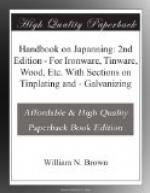of shellac varnish, the necessary pigments for colouring
being added thereto, being mixed with the shellac
varnish after they have been ground into a high degree
of smoothness and fineness in spirits of turpentine.
In japanning it is best to have the oven at rather
a lower temperature, increasing the heat after the
work has been placed in the oven. When a sufficient
number of coats have been laid on—which
will usually be two only—the work must
be polished by means of a piece of cloth or felt dipped
in tripoli or finely powdered pumice-stone. For
white grounds fine putty powder or whiting must be
employed, a final coat being afterwards given, and
the work stoved again. The last coat of all is
one of varnish. And here, as a preliminary remark,
it is advisable that all enamels and japans should
be purchased ready-made, as any attempt to make such
is almost sure to end in disaster, while, owing to
the fact that such are only required for small jobs;
it would involve too much trouble and would not pay.
It is for this reason that few japan recipes are given,
as, although many are available, they do not always
turn out as suitable for the purpose as could be desired,
in addition to which the ready-made articles can be
purchased at a very reasonable price and are much
better prepared. The operator should procure his
enamels a shade or two lighter than he desires to see
in the finished article, allowing the chemical action
due to the stoving to tone the colours down.
Another necessity is to keep the enamel thoroughly
well mixed by well stirring it every time it is used,
as if this is not done the actual colouring matter
is apt to sink to the bottom, the ultimate result
being that streaky work is produced in consequence
of this indifferent mixing of the enamelling materials.
It is hardly necessary to state that all japanning
or enamelling work must be done in a room or shop
absolutely free from dust or dirt, and as far away
as possible from any window or other opening leading
to the open air, for two reasons—one being
that the draught therefrom may cool the oven or stove,
and the other that the air may convey particles of
dust into the enamelling shop. In fact, it cannot
be too much impressed upon the workmen that one of
the primary secrets of successful enamelling is absolute
cleanliness; consequently all precautions must be
taken to ensure that the enamel is perfectly free
from grit and dust, and it must be so kept by frequent
straining through fine muslin, flannel, or similar
material. The work having been thoroughly cleaned
and freed from all grease and other foreign matter,
it must be suspended or held immediately over the pan
elsewhere referred to, and the enamel poured on with
an ordinary iron ladle, or covered by means of the
brush. When it has been permitted to drain thoroughly,
the work should be hung on the hooks on the rods in
the oven as seen in the explanatory sketch, care being
observed that no portion of the work is in such a
position that any superfluous enamel cannot easily
drain off—in other words, the work must
lie or hang that it is always, as it were, on the
slant. Always bear in mind when shutting the
oven door to do so gently, as if a slam is indulged
in all the gas jets will be blown out, and an explosion
would probably result.




